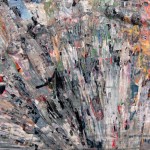When's a circle a circle? Tried it out today when I found a small mountain…
Giotto’s O
Came across the circle as an emblem of perfection today – am reading about Dante’s Italy in that absobing format that is historical fiction.
From The Master of Verona chapter 1, page 11.
“Giotto’s O.”
In the middle of a dream in which no one would let him sleep, it seemed to Pietro that the words were deliberately meant to annoy him. Almost unwillingly he reamed of a rock, a paintbrush touching the rock, forming a perfect circle.
The painter used red. It looked like blood.
“Pietro, I’m speaking to you.”
Pietro sat up straight in the rattling coach. “Pardon, Father.”
“Mmm. It’s these blasted carriages. Too many comforts these days. Wouldn’t have fallen asleep in a saddle.”
It was dark with the curtains drawn, but Pietro easily imagined his father’s long face grimacing. Fighting the urge to yawn, Pietro said, “I wasn’t asleep. I was thinking. What were you saying?”
“I was referencing Giotto’s mythic O.”
“Oh. Why?”
“Why? What is nobler than thinking of perfection? More than that, it is a metaphor. We end where we begin.”
From Giorgio Vasari’s Lives of the Artists, as translated by Adrienne DeAngelis
“After this he [Giotto] was called to Assisi by Fra Giovanni di Muro, at that time general of the order of S. Francis, and painted in fresco in the upper church thirty-two stories from the life and deeds of S. Francis, which brought him great fame. It is no wonder therefore that Pope Benedict sent one of his courtiers into Tuscany to see what sort of a man he was and what his works were like, for the Pope was planning to have some paintings made in S. Peter’s. This courtier, on his way to see Giotto and to find out what other masters of painting and mosaic there were in Florence, spoke with many masters in Sienna, and then, having received some drawings from them, he came to Florence. And one morning going into the workshop of Giotto, who was nat his labours, he showed him the mind of the Pope, and at last asked him to give him a little drawing to send to his Holiness. Giotto, who was a man of courteous manners,immediately took a sheet of paper, and with a pen dipped in red, fixing his arm firmly against his side to make a compass of it, with a turn of his hand he made a circle so perfect that it was a marvel to see it Having done it, he turned smiling to the courtier and said, “Here is the drawing.”. But he, thinking he was being laughed at, asked, “Am I to have no other drawing than this?” “This is enough and too much,” replied Giotto, “send it with the others and see if it will be understood.” The messenger, seeing that he could get nothing else, departed ill pleased, not doubting that he had been made a fool of. However, sending the other drawings to the Pope with the names of those who had made them, he sent also Giotto’s, relating how he had made the circle without moving his arm and without compasses, which when the Pope and many of his courtiers understood, they saw that Giotto must surpass greatly all the other painters of his time. This thing being told, there arose from it a proverb which is still used about men of coarse clay, “You are rounder than the O of Giotto,” which proverb is not only good because of the occasion from which it sprang, but also still more for its significance, which consists in its ambiguity, tondo, “round,” meaning in Tuscany not only a perfect circle, but also slowness and heaviness of mind.”
| « Conceptual circle | <-- previous post | next post --> | Barcelona » |
|---|








